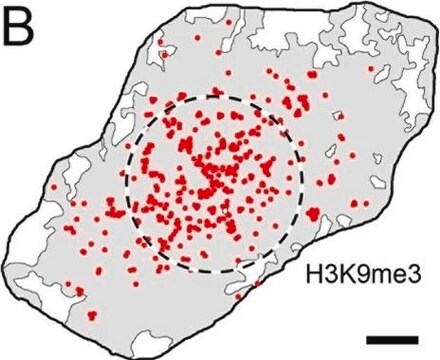04-858
Anti-Histone H4 Antibody, pan, rabbit monoclonal
culture supernatant, clone 62-141-13, Upstate®
Synonym(s):
H4, Histone H4
About This Item
Recommended Products
biological source
rabbit
Quality Level
antibody form
culture supernatant
antibody product type
primary antibodies
clone
62-141-13, monoclonal
species reactivity
Saccharomyces cerevisiae, human, vertebrates, chicken
manufacturer/tradename
Upstate®
technique(s)
ChIP: suitable
multiplexing: suitable
western blot: suitable
isotype
IgG
NCBI accession no.
UniProt accession no.
shipped in
dry ice
target post-translational modification
unmodified
Gene Information
human ... H4C1(8359)
General description
Specificity
Immunogen
Application
A 1:100,000 dilution of a previous lot detected unmodified recombinant Histone H4 protein (Catalog # 14-412) and Histone H4 in acid extracts from both untreated HeLa cells and cells treated with sodium butyrate (hyper-acetylated) or colcemid (hyper-phosphorylated) (Figure B).
Chromatin Immunoprecipitation:
An independent laboratory used a previous lot of this antibody in chromatin immunoprecipitation (Issac, C., 2006).
Multiplexing:
Serial dilutions of a previous lot were incubated with histone peptides containing various unmodified peptides spanning the aminoterminus of Histone H4 conjugated to Luminex® microspheres. The antibody recognized both modified and unmodified peptides.
Epigenetics & Nuclear Function
Histones
Quality
Target description
Linkage
Physical form
Storage and Stability
For maximum recovery of product, centrifuge the vial prior to removing the cap. Aliquot into microcentrifuge tubes and store at -20°C. Avoid repeated freeze/thaw cycles, which may damage IgG and affect product performance.
Analysis Note
Recombinant Histone H4 (Catalog # 14-412) or HeLa cell acid extract.
Legal Information
Disclaimer
Not finding the right product?
Try our Product Selector Tool.
recommended
Storage Class Code
12 - Non Combustible Liquids
WGK
WGK 1
Flash Point(F)
Not applicable
Flash Point(C)
Not applicable
Certificates of Analysis (COA)
Search for Certificates of Analysis (COA) by entering the products Lot/Batch Number. Lot and Batch Numbers can be found on a product’s label following the words ‘Lot’ or ‘Batch’.
Already Own This Product?
Find documentation for the products that you have recently purchased in the Document Library.
Our team of scientists has experience in all areas of research including Life Science, Material Science, Chemical Synthesis, Chromatography, Analytical and many others.
Contact Technical Service








